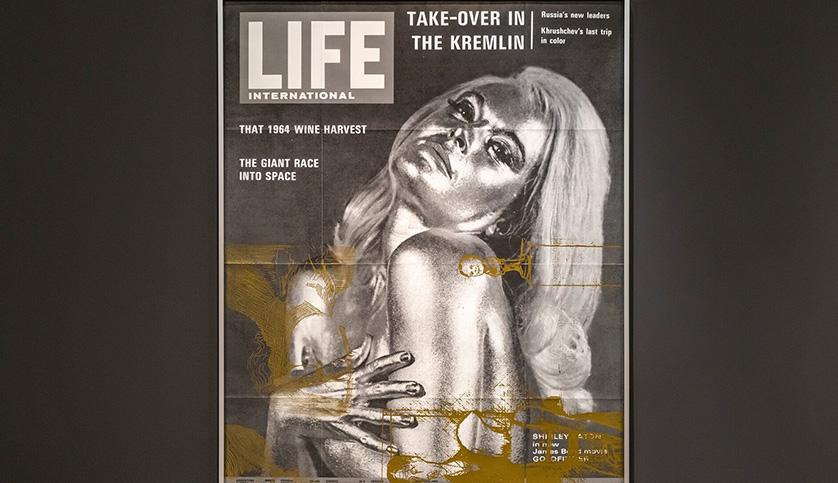February 23 - August 8, 2021
A Question of Taste was a group exhibition that deals with kitsch, a concept whose meaning has shifted since the 19th century, and the intimate relationship this concept has established with today's visual culture as well as its critical role in shaping taste.
The word kitsch, which has been used to describe cheap and popular paintings or sketches in post-industrial Germany, gradually transformed into a complex concept that found its place in various languages, untranslated. In this era when diversity, ambiguity, and ineffability are sanctified, can kitsch be a tool to carry these values forward? Could thinking about avant-garde and kitsch side-by-side rather than in opposition — by looking closely at contemporary art's relations with the collective aspects of mass culture, rather than considering mass culture as unsubstantial, banal and inferior, and trying to explore the ties between them — agitate the existing structure of class society? Is it possible to define taste as something other than an indicator of class?
Taste may still be an indication of class today, but the structure of the mechanisms that feed and strengthen this signal has now become different. A Question of Taste brought together works of thirteen artists and collectives and focused on the concept of taste as a class indicator; looks at the sense of aesthetics, and its values ascribed to the East and the West. Focusing on the rise of mass culture against high art, it aimed to explore the rich uses of the concept of kitsch in dialogue with the artists, and based on the relationship between art and visual culture that has been shaped in the process of transition from material culture to digital culture. It questions the concept of taste, which reinforces the separation of classes within the societal structure, through both objects, and the visual language that has dominated the Internet since the early 90s.
Curated by Ulya Soley, the exhibition featured the artists Alex Da Corte & Jayson Musson, Bruno Miguel, Cameron Askin, FAILE, Farah Al Qasimi, Gülsün Karamustafa, Hayırlı Evlat, Miao Ying, Nick Cave, Olia Lialina & Mike Tyka, Pierre et Gilles, Slavs and Tatars and Volkan Aslan.
Images
Nick Cave
Drive-by, 2011
Video, 10’05’’
© The artist, Jack Shainman Gallery
Farah Al Qasimi
It’s Not Easy Being Seen 7, 2016
Archival inkjet print, 120 x 96 cm
© The artist, The Third Line
Alex Da Corte
In collaboration with Jayson Musson
Easternsports, 2014
Soundtrack: Devonté Hynes
four-channel video, 146’
Tile, carpet, neon, metal chairs, artificial oranges, diffusers, orange essential oil
© The artist, Sadie Coles and Salon94
Pierre et Gilles
Flowers and Tears (Lolly Wish), 2016
Inkjet photograph printed on canvas and painted, 174 x 126 cm
© The artist, Galerie Templon
Olia Lialina
In collaboration with Mike Tyka
*Treasure Trove*, 2017
HTML, JS, GIFs
© The artist
Gülsün Karamustafa
Watermelon, 1986
Textile, found object, 100 x 143 cm
© The artist, Büro Sarıgedik
Volkan Aslan
Nice to See You, 2021
Installation with porcelain figures produced by the artist, and Suna and İnan Kıraç Foundation Kütahya Tiles and Ceramics Collection
© The artist
Commissioned for the exhibition A Question of Taste.
3D Virtual Tour
Exhibition Catalogue

The catalogue accompanying the exhibition features the curatorial text of Ulya Soley, which focuses on the concept of taste as a class indicator; looks at the sense of aesthetics, and its values ascribed to the East and the West; the rise of mass culture against high art, exploring the rich uses of the concept of kitsch in dialogue with the artists, and based on the relationship between art and visual culture that has been shaped in the process of transition from material culture to digital culture.

Pera Museum presents virtual event series “Stage of Plastic Dreams” in collaboration with HYPERCORTEX and with the support of the British Council. Organized in parallel to the A Question of Taste exhibition, the “Stage of Plastic Dreams” event series brings musicians and visual artists together in a virtual event space open to participants.
Pera Learning
Pera Museum Learning Programs organizes Different Tastes for Different Folks in parallel to the exhibition A Question of Taste. The program offers different age groups fun and various discoveries through online workshops and tours.
With inspiration from “A Question of Taste” and “Etel Adnan: Impossible Homecoming” exhibitions, Pera Museum Learning Programs hosts art and science workshops, inquiry-based philosophy workshops, and online exhibition tours with material kits to be posted to the addresses of 7-12 aged participants.

Inspired by the exhibition And Now the Good News, which focusing on the relationship between mass media and art, we prepared horoscope readings based on the chapters of the exhibition. Using the popular astrological language inspired by the effects of the movements of celestial bodies on people, these readings with references to the works in the exhibition make fictional future predictions inspired by the horoscope columns that we read in the newspapers with the desire to receive good news about our day.

Nam June Paik was video art’s pioneer (1932 –2006). It is interesting that while Warhol and Nameth were experimenting with psychedelic happenings that combined rock, film and performance, the video art pioneers Nam June Paik, Stephen Beck, Eric Siegel and Steina Vasulka were researching in a similar direction.

Pera Museum, in collaboration with Istanbul Foundation for Culture and Arts (İKSV), is one of the main venues for this year’s 15th Istanbul Biennial from 16 September to 12 November 2017. Through the biennial, we will be sharing detailed information about the artists and the artworks.
Tuesday - Saturday 10:00 - 19:00
Friday 10:00 - 22:00
Sunday 12:00 - 18:00
The museum is closed on Mondays.
On Wednesdays, the students can
visit the museum free of admission.
Full ticket: 300 TL
Discounted: 150 TL
Groups: 200 TL (minimum 10 people)